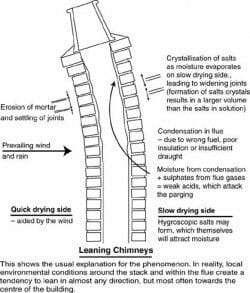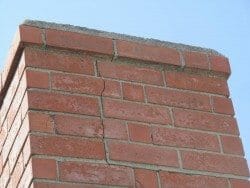Leaning Fireplace Chimney: Causes and Concerns
Home » Furnaces, AC's & Fireplaces » Chimneys »

One of the main reasons for a brick or stone fireplace chimney to lean or pull away from a home deals with the footing under the chimney. Chimneys are very heavy and usually sit on a very small pad or footing. Often this pad is not attached to the homes’ main footing. Whether it’s monolithically connected or not; it is one the first thing you may want to examine if the chimney leans.
How do I know if my chimney is leaning?
If there is a gap between the homes wall and the exterior chimney, then your chimney is probably leaning. Sometimes homeowners will fill the gap or space with mortar, caulking or foam insulation which helps prevent water intrusion into the gap. If you stand back and position yourself against the homes wall, you will usually see visible signs that the chimney is leaning. Another way is to place a level on the chimney, the longer the level the better.
Concern
The higher the chimney and the more it leans, the more concern one should have. Since chimneys weigh a lot they can cause lots of damage should they fall. If there is severe cracking, then the concern level rises. Fortunately, chimneys seldom fall and most have metal straps connected to them which are connected to the homes framing in the attic. Home inspectors and fireplace inspectors will normally check these connections, but if covered by insulation, then most home inspectors will not move the insulation and check the strapping connections.
Attic area straps
Many fireplace are partially secured with metal straps that tie or hold the chimney somewhat from pulling away from the house. These straps, at times, may be visible in the attic area and are connected to the framing in the attic. If there are straps, a check to see if they are properly installed is wise, especially if the fireplace is pulling away from the house. In earthquake areas these straps can help prevent a chimney from pulling away and collapsing. Concerns with fireplaces and chimneys are generally best addressed to a fireplace contractor and/or a fireplace inspector. (Read about 3 LEVELS OF FIREPLACE AND CHIMNEY INSPECTIONS )
Causes for Footing / Pad issues
Under sized: Footings that are undersized for the weight that they are carrying may result in a chimney tilting or pulling away from the home. Just can’t carry the heavy weight.
Poor soil load bearing capacity: All soils are not the same; some will support heavy loads others will not.
Expansive soils: Expansive soils will expand when they get wet and shrink when they become dry. This can cause a footing or pad to rise up and down, depending how dry or wet the soil is.
Drainage issues: It is desirable for water to drain away from the foundation. When there is poor drainage a foundation may settle or sink, if expansive soils it may raise. This can result in damage to the footing and possibly to the load that it is carrying.
Heaving from frost: In cold climates and areas with severe cold winter months, it is generally a requirement that footings be below the frost line. If a footing is not, then movement may occur. The frost may cause the footing to rise. Basically the footing is too shallow.
Poor quality of concrete or insufficient steel reinforcement: Concrete that is has a low PSI strength will not always support a heavy weight. Also, if there is not sufficient rebar in the concrete pad, then the pad may fail.
Cracks
Chimneys will often have cracks in them. These cracks occur for a number of reasons, including movement of the chimney do to earthquakes or soil movement. Lack of maintenance, weather type issues, especially ones dealing with freezing and thawing will cause cracks. Antennas attached to chimneys, trees hitting the chimney in a storm or vines slowing growing in the mortar joints may likewise cause cracks.
Chimneys cracks can usually be repaired and are often looked upon as a maintenance issue, but chimneys that are leaning significantly are more difficult straighten up.



